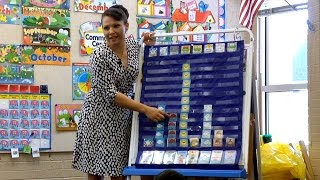This video describes children’s ability to compare two groups and notice if one has more or less. It also provides examples of how early childhood professionals can both explicitly teach this skill and support its development through daily routines and play. This video is part of a series describing children’s early mathematical development and showing how professionals can support this development.
See supporting materials and related videos at http://www.easternct.edu/cece/elds-math-comparison/.
Copyright 2016 by the Connecticut Office of Early Childhood. Produced by the Center for Early Childhood Education at Eastern Connecticut State University. This video may only be used for educational purposes.
Read Transcript
Dr. Sudha Swaminathan: “Comparison is an important aspect in number sense. Because fundamentally, when we count, we have a purpose. We’re trying to determine if we have enough, if we need more.” Caregiver: “We’re building a fort.” Child: “This is more.” Sudha Swaminathan: “So, comparison leads us to think about that intentionally. So, when you have two groups, say a group of four and a group of three, you want children to be able to determine which group has more. And originally, they might count the numbers and they start to compare those quantitatively. Sometimes they compare it visually. Which looks like it has more?” Child: “That one’s big. That one’s little.” Narrator: “Adults can support children’s ability to compare amounts throughout the day. Daily routines provide opportunities to practice this skill in meaningful ways.” Teacher: “Somebody talk to me about those numbers. We’ve got four boys, and four girls. Yes, Jordan.” Child: “It’s the same.” Teacher: “It’s the same number.” Yotisse Williams: “Lunchtime even, you know, some of the kids have fruits and vegetables and we were counting the number of fruits and the number of vegetables. Who had the most, who had the least?” Narrator: “While exploring materials, children naturally encounter differing amounts.” Sudha Swaminathan: “So, when they’re playing with play-doh, and they have a lot of play-doh, and someone else has a little bit, they’re able to make those comparisons.” Boy: “Mine is getting higher than yours.” Girl: “Yeah.” Boy: “don’t you know that?” Girl: “Yeah.” Narrator: “Adults can support children to make comparisons during play.” Teacher: “What size is this?” Child: “Smaller.” Teacher: “Yeah. And this?” Child: “Bigger.” Narrator: “Through planned activities, children’s development if this skill can be strengthened.” Teacher: “It’s your job to figure out who has more. Which one is more – yellow or green?” Child one: “One, two, three, four, five, six, seven.” Child two: “I think I have more.” Child one: “One, two, three…” Sudha: “These comparisons of numbers and quantity leads them gradually to arithmetic to looking at what’s more, what comes after, realizing that one more in a number sequence means one more in a quantity.” Parent: “Wait, how many do we have hanging on there so far?” Child: “Two. Now we’re going to have three.” Sudha: “And those basic, foundational skills are built when they start to compare groups.”






